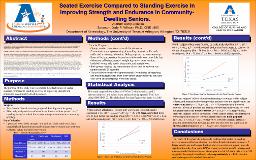
ATTENTION: The works hosted here are being migrated to a new repository that will consolidate resources, improve discoverability, and better show UTA's research impact on the global community. We will update authors as the migration progresses. Please see MavMatrix for more information.
Show simple item record
| dc.contributor.author | Zelaska, Karly | |
| dc.date.accessioned | 2019-04-09T22:53:21Z | |
| dc.date.available | 2019-04-09T22:53:21Z | |
| dc.date.issued | 2018-12 | |
| dc.identifier.uri | http://hdl.handle.net/10106/27930 | |
| dc.description | KINE 4400 | |
| dc.description.abstract | **Please note that the full text is embargoed** ABSTRACT: INTRODUCTION: Wellness and preventive exercise programs are being introduced and becoming more prevalent in senior-living communities. These programs are put in place to reduce the recurring costs of hospitalizations and medical services, as well as to maintain or improve independence in these populations. Oftentimes, chair-based exercises are used to perform resistance training because of the ease, simplicity, and safety that they provide to these senior residents. Many studies have explored the effects that a variety of aerobic and strengthening programs have on improving balance and reducing fall risk in seniors, what remains unanswered is whether doing seated or standing exercises is effective on improving strength and endurance in these elderly populations.
PURPOSE: The purpose of this study was to compare the effectiveness of seated exercise compared to standing exercise in improving strength and endurance in community-dwelling seniors.
METHODS: Thirteen community-dwelling seniors (seated: n = 7, standing: n = 6, mean ± SD age, height, and weight: = 79.1 ± 8.5 years, 77.7 ± 11.3 years, 162.7 ± 4.6 cm, 160.5 ± 8.1 cm, 75.5 ± 17.1 kg, and 66.1± 23.3 kg, respectively) participated in twelve group exercise classes (twice a week) over the span of six weeks. Upper and lower body strength (arm curl and chair stand tests), hand strength (hand dynamometer) and endurance (two-minute step test) were evaluated before and after intervention. This study required four mixed ANOVAs (2 within subjects and 2 between subjects) and values were analyzed using a paired, 2-tail test using IBM SPSS 22. The alpha level for significance was set to p <0.05.
RESULTS: Between subjects’ effects of position (standing vs sitting) was not significant in the chair stand test (p = .178). Within subject effects (pre- to post-test) were not found to be statistically significant from before and after intervention (p = .151). No statistically significant interaction between position and the chair stand test was found (p = .879). Between subjects’ effects of position was not significant in the biceps curl test (p = .933). Within subject effects were found to be statistically significant F (1, 11) = 10.69, p = .007, ηp2 = .49 with biceps curls from pretest to post-test in the standing group (Pre = 19.33 ± 5.82; Post = 21.67 ± 5.32) and in the seated group (Pre = 19.57 ± 3.31; Post = 21.00 ± 3.92) improving. No statistically significant interaction between position and the biceps curl test was found (p = .448). Between subjects’ effects of position was not significant in the hand grip test (p = .933). Within subject effects were not found to be statistically significant from before and after intervention (p = .748). No statistically significant interaction between position and the hand grip test was found (p = .627). Between subjects’ effects of position was not significant in the two-minute step test (p = .139). Within subject effects were found to be statistically significant F (1, 10) = 9.53, p = .012, ηp2 = .49 with overall endurance from pretest to post-test in the standing group (Pre = 76.60 ± 14.42; Post = 95.00 ± 10.61) and in the seated group (Pre = 72.00 ± 17.23; Post = 80.00 ± 15.60) improving. No statistically significant interaction between position and the two-minute step test was found (p = .252).
CONCLUSION: The results of this study do not provide evidence that seated or standing exercise is more effective at improving strength and endurance in community-dwelling seniors. However, the exercise program accounted for a 49% increase in upper body strength and endurance in these subjects. A bigger sample size and longer duration of exercise intervention may be able to provide significant results. | en_US |
| dc.description.sponsorship | Faculty Sponsor: Judy R. Wilson | en_US |
| dc.language.iso | en_US | en_US |
| dc.publisher | The University of Texas at Arlington | en_US |
| dc.subject | Seated exercise | en_US |
| dc.subject | Standing exercise | en_US |
| dc.subject | Community-dwelling seniors | en_US |
| dc.subject | Strength | en_US |
| dc.subject | Endurance | en_US |
| dc.title | Seated Exercise Compared to Standing Exercise In Improving Strength and Endurance in Community-Dwelling Seniors. | en_US |
| dc.type | Presentation | en_US |
| dc.publisher.department | Department of Kinesiology | |
Files in this item
- Name:
- ZelaskaPoster.pdf
- Size:
- 707.2Kb
- Format:
- PDF
- Description:
- PDF
This item appears in the following Collection(s)
Show simple item record


